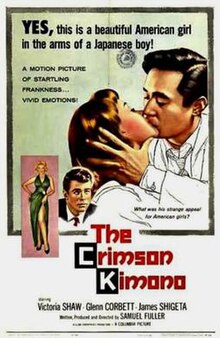The Crimson Kimono
| The Crimson Kimono | |
|---|---|

Theatrical release poster
|
|
| Directed by | Samuel Fuller |
| Produced by | Samuel Fuller |
| Screenplay by | Samuel Fuller |
| Starring |
Victoria Shaw Glenn Corbett James Shigeta |
| Music by | Harry Sukman |
| Cinematography | Sam Leavitt |
| Edited by | Jerome Thoms |
|
Production
company |
Globe Enterprises
|
| Distributed by | Columbia Pictures |
|
Release date
|
October 1959 |
|
Running time
|
82 minutes |
| Country | United States |
| Language | English |
The Crimson Kimono is a 1959 film noir directed by Samuel Fuller. The film stars James Shigeta, Glenn Corbett and Victoria Shaw.
It featured several ahead-of-its-time ideas about race and society's perception of race, a thematic and stylistic trademark of Fuller.
The film is essentially about two cops, friends and Korean War veterans, Detective Joe Kojaku (James Shigeta) and Detective Sgt. Charlie Bancroft (Glenn Corbett), who attempt to solve the murder of a local entertainer. A love triangle soon develops between a key witness, Christine Downes (Victoria Shaw), and the two principal leads.
A stripper runs out onto a Los Angeles street in the Little Tokyo district, in a state of undress, mortally wounded by a gunshot. Police detectives Joe Kojaku and Charlie Bancroft, partners and bachelors who share an apartment, are assigned to the case. They find portraits of the stripper, known as Sugar Torch, dressed in a kimono as a geisha, apparently preparing a Japanese-themed act.
The cops search for a man who had been helping the stripper with her act. They interview a student artist, Christine Downes, who draws a sketch of the man for them, and Charlie develops a romantic attraction to her. They meet a man named Hansel who did the portrait of the dead woman and a wigmaker, Roma, who provided the wig for the stage act.
Joe worries for Christine's safety, that her sketch could result in the killer coming after her. He, too, begins to fall for Chris, and the interest is mutual. Charlie's facial reaction makes Joe believe that he resents the multi-racial nature of the relationship. Joe aggressively attacks Charlie during a martial-arts competition, then decides to quit the force, disillusioned after having felt for so long that his partner was free of this kind of racial bias. Charlie confronts Joe, telling him that the look he saw on his face was a flash of hatred for the envy and betrayal he felt towards Joe and his relationship with Chris, and was not racism. Joe doesn't believe him.
A shot is taken at Christine, and it is assumed Hansel is the man behind the killings. It instead turns out to be Roma, who considered the stripper a threat to her relationship with Hansel because of a look that Hansel gave Sugar Torch. Joe relates this to Charlie, and realizes that just as Roma saw what she wanted in Hansel's face, Joe projected his own struggles with racism onto Charlie. Joe asks Charlie if they can still be partners, and Charlie tells him no, that he will always have bad feelings about Joe and Chris. The movie ends with Joe and Chris embracing.
...
Wikipedia
